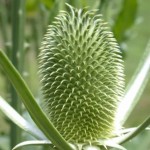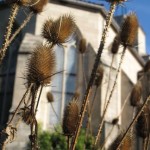 |
 |
 |
Above, from left to right: The seed head of the cultivated form of teasel (Dipsacus sativus) in a bed devoted to plants used in medieval arts and crafts (2006); detail of the seed head of the teasel growing in the same bed this year; detail of the seed head of common teasel, or fuller???s teasel (D. fullonum),??now in the medicinal bed.
Visitors to Bonnefont Garden are often surprised to find plants that they recognize as common weeds being carefully cultivated in the beds here. One ubiquitous weed found growing in waste places throughout this country is the common or wild teasel, Dipsacus fullonum, a plant which had various medicinal applications in the European Middle Ages. A distinct but closely related form of teasel, D. sativus, was also introduced here in colonial times, and was cultivated for use in the woolen trade. Both forms have naturalized in the United States (see the U.S.D.A. website), although the wild or common teasel, D. fullonum, is much more widespread than the cultivated variety. There is considerable confusion between the two, and sometimes seed sold as the cultivated form turns out to be the common variety.
Teasel is so called because of the use of the spiny seed heads to tease out woolen fibers before they were spun, a process known as carding, and in raising the nap of finished woolen cloth. While the conical heads of wild or common teasel (Dipsacus sylvestris) may once have been employed in wool carding (some authorities question this) and are sometimes used on a small scale by hand-spinners, they are of no use in raising nap, as the spines are too straight and weak to be effective. The curved cylindrical seed heads of the cultivated form were and are considered to be superior to any other instrument for that purpose. The hooked spines of this form “give” when they are drawn over the cloth, smoothing it rather than snagging it. In the Middle Ages, teasel heads were fitted into wooden frames. In the nineteenth century, the frames might be placed on rotating drums over which the cloth was passed. Although teasel heads began to be replaced with steel brushes in English woolen mills in Victorian times, the very finest finish, especially that of the baize used for high-quality billiard tables, is still produced with teasel.
At one time, D. sativus was considered to be a subspecies of D. fullonum, but the two are now considered to be distinct. The botanical names are somewhat misleading, as the common or wild variety is now known as Dipsacus fullonum???the teasel of the “fullers,” or cloth makers???while the specialized, historically important form used in the wool trade since the Middle Ages is known simply as Dipsacus sativus. ???Sativus??? is the botanical epithet given to a plant known in a cultivated form that may no longer have an independent existence as a wild species. D. sativus may have been selectively bred for its useful qualities in early times.
We grow both teasels here at The Cloisters, although the common teasel is given a place in our medicinal collection and the cultivated form is grown in the bed devoted to plants used in medieval arts and crafts. This year, the plants that matured from seed sown as D. sativus in the spring of 2008 proved to be the wrong kind and we will need to obtain seeds from a reliable source for planting next spring.
More to come on the medieval medicinal uses of the wild teasel . . .
???Deirdre Larkin
Sources:
Griffiths, Mark. The New Royal Horticultural Society Index of Garden Plants. Portland, OR: Timber Press, 1992.
Mabey, Richard. Flora Brittanica. London: Chatto & Windus, 1996.
Ryder, Michael. “Fascinating Fullonum,” Circea: The Journal of the Association for Environmental Archaeology, 1993.
Tags: Dipsacus fullonum, Dipsacus sativus, fuller???s teasel

October 16, 2009 at 7:59 pm
So nice to know I have a plant that was in the medieval garden! I bought mine because of the catalog description talking about carding wool. I guess I must have the medicinal one. Learn something new always from your blog! Thanks.
October 21, 2009 at 11:51 am
is teasel the same as thistle? they look so much alike. i love using these wild ones as standalones in vases. they are fascinating to look at. I love its history as part of carding wool. thanks, again, for this information. thea
October 23, 2009 at 4:03 pm
As a surprise birthday gift for my Friend on October 22nd, I took her to the Cloisters. We arrived just in time for the Garden Tour, which was very enjoyable and we both learned so much about the preferred garden variety flora of those times. Although I can’t recall the name of our Tour Guide, she was a joy to learn from! She was very pleasant and most informative. I voiced a question at the end of the tour and the Guide told me to come to this sight and ask. My question is this…Did any of the herbal gardens include the herb “Bitter Vetch”, also known as, “Heath Pea”? I have tried to locate this Scottish native plant here in the states with limited information. Perhaps you can help. Thank You for your time. I am looking forward to hearing from you in the future…..Dee/Windsong
October 29, 2009 at 4:56 pm
Hi, Nancy—
There’s seems to be some disagreement as to whether teasel was formerly used to card wool—i.e, to clean and separate the raw fibers. Its primary use was to raise the nap on woolen cloth once it was woven. I think you probably do have the wild or medicinal one.
November 25, 2009 at 12:37 pm
Hello, Dee—
Please forgive the unconscionably long time it has taken me to get back to you, but I wasn’t familiar with the plant you mentioned and needed to do a little research.
Bitter vetch or heath pea (Lathyrus linifolius or Lathyrus montanus)
is not on our medieval plant list (compiled from many sources over many years) and has not been grown here at The Cloisters, nor could I find it in any of the standard references on medieval medicinal plants.
I did find some references online. Bitter vetch seems to have gotten a lot of attention in the U.K. press in recent years as a possible aid in weight loss. This member of the pea family was among the medicinal plant remains discovered at an archaeological excavation of the fourteenth century Soutra Aisle monastery near Edinburgh.
My guess would be that the use of the heath pea might have been very local. It may not have been used as an appetite suppressant outside of Scotland, although the RHS Index to Garden Plants lists it as native to central and western Europe.
Vetches have been resorted to as famine foods for many centuries.
It may be that the appetite-suppressing property of the bitter vetch was discovered in that way. In any case, I will be looking for more information on medieval usage and documentation, and may well add it to our plant list. Thank you for the lead!
December 20, 2012 at 8:47 pm
[...] [1] ???Two Teasels: The Medieval Garden Enclosed,??? Metropolitan Museum of Art, The Cloisters Blog. /cloistersgardens/2009/10/16/two-teasels/ [...]